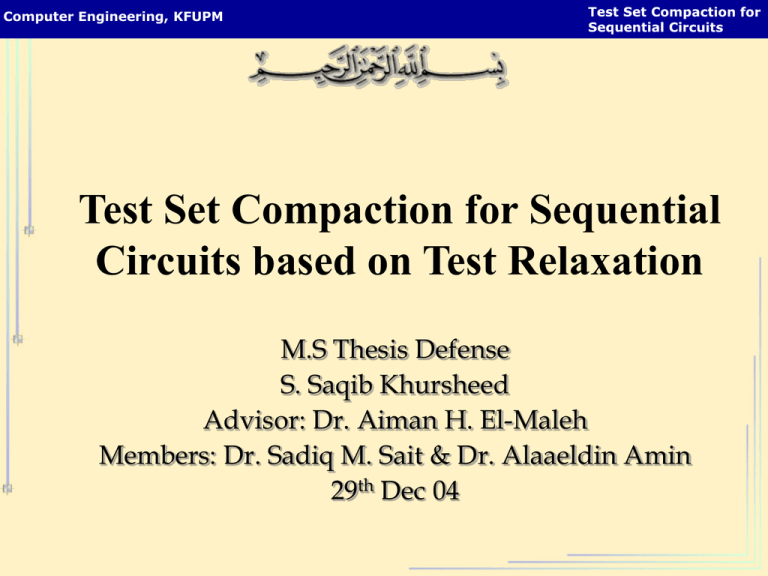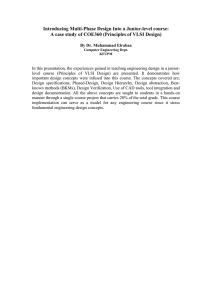Test Set Compaction for Sequential Circuits based on Test Relaxation
advertisement

Computer Engineering, KFUPM Test Set Compaction for Sequential Circuits based on Test Relaxation M.S Thesis Defense S. Saqib Khursheed Advisor: Dr. Aiman H. El-Maleh Members: Dr. Sadiq M. Sait & Dr. Alaaeldin Amin 29th Dec 04 Computer Engineering, KFUPM Outline • • • • • • Motivation State of the Art Static Compaction Algorithms Test Relaxation Algorithm Proposed Algorithms and Experimental Results Limitations of Justification algorithm Conclusion & Future Work 2 Computer Engineering, KFUPM Motivation • Compaction is the process of reducing the size of test set while maintaining the fault-coverage. • To overcome High Complexity of Sequential ATPGs • To reduce Test Application Time reduced cost! • To overcome Memory Limitations of the Tester. 3 Computer Engineering, KFUPM Types of Compaction Algorithms • Static Compaction Compaction Algorithms are applied as a post-processing step to test generation process. • Dynamic Compaction Compaction Algorithms are incorporated in test generation process. • Static Compaction is more useful than Dynamic Compaction in Sequential Circuits. 4 Computer Engineering, KFUPM State-of-the-art Static Compaction Algorithms • Some of the popular algorithms include: – Vector Restoration • Linear Reverse Order Restoration (LROR) • Radix Reverse Order Restoration (RROR) • SIngle FAult Restoration (SIFAR) • Mixed Mode (MISC) • SECO – Subsequence Merging – State Traversal based on Relaxed States 5 Computer Engineering, KFUPM LROR Snapshot of algorithm under execution Restoring Targeting Restoringfvector 11 and f2..#Restoring 4, 5 and 6, vector detects#6 #the 5doesn’t and fault 6, fdoesn’t 1detect and f2.the fault detect the faults f1 and f2 detected Restored vector # 4, 5 and 6, are concatenated with previously restored test vectors . 6 Computer Engineering, KFUPM State-Traversal 7 Computer Engineering, KFUPM Important Attributes of Static Compaction Algorithms • Test sequences for Hard-to-Detect faults (HTDF) can easily detect Easy-to-Detect faults (ETDF). • State Traversal eliminates redundant vectors • Merging of relaxed Subsequences adds another level of freedom to test compaction. • Increasing the Fault coverage fuels compaction. 8 Computer Engineering, KFUPM Test Relaxation Algorithm • Restoration algorithms rely on vector-by-vector fault simulation to extract the test sequence. • Recently, an efficient Test Relaxation technique has been proposed to extract the necessary assignments for detecting the faults. • Our algorithms (discussed next) rely on test relaxation algorithm for extracting the self-initializing subsequence. • A relaxed test set facilitates Subsequence Merging and State Traversal. 9 Computer Engineering, KFUPM Proposed Algorithms • Following algorithms are proposed: – Linear Reverse Order Restoration • with State Traversal • with State Traversal-2 – Merging Restoration – Hybrid Schemes • Hybrid-I • Hybrid-II – Fault-Coverage based Compaction • FC-LROR • FC-MR 10 Computer Engineering, KFUPM Reverse Order Restoration with State Traversal using Relaxed Test Set After first pass of fault Start from last time frame simulation, information is having un-justified fault. stored Justification of faults f4, f5. Self-initialized subsequence is found by relaxation algorithm. f4 and f5 detected State Traversal may further reduce the size of Reduced subsequence subsequence f4 and f5 detected Re-current states, removal of time frames is possible 11 Computer Engineering, KFUPM Reverse Order Restoration with State Traversal using Relaxed Test Set 0/1 1/x 1/0 Fault Simulate the subsequence and drop all the faults detected f4, f5, f1 and f2 are detected Dropping detected faults leaves f3 The above steps are repeated Fault # 3 is justified. 0/x 1/x x/0 Concatenation with previously justified test vectors. Test Set after Compaction detecting all the faults. 12 Computer Engineering, KFUPM Motivation behind ST-2 STRATEGATE Test Sequences LROR LROR-ST Ckt TS TS (sec) TS (sec) s298 194 152 (0.06) 134 (0.06) s344 86 44 (0.03) 44 (0.09) s641 166 133 (0.07) 157 (0.11) s713 176 115 (0.07) 134 (0.1) s820 590 469 (0.27) 466 (0.39) s832 701 534 (0.31) 470 (0.42) s1196 574 268 (0.3) 268 (0.35) s1238 625 268 (0.33) 268 (0.37) s1488 593 466 (0.56) 479 (0.71) s1494 540 453 (0.52) 401 (0.7) s5378 11481 760 (45.34) 726 (45.34) s35932 257 131 (20.8) 131 (21.12) Total (sec) 15983 3793 (68.66) 3678 (69.76) 13 Computer Engineering, KFUPM Merging Restoration • Merging algorithm follows the same flow as the previous algorithm. • Instead of concatenation of subsequences, relaxed subsequences are merged with previously restored subsequences. • Merging towards bottom • Merging towards top 14 Computer Engineering, KFUPM Merging towards Bottom 11xx 0x01 11xx X X 0x01 10x1 1011 xxx0 11x0 00x1 0011 11xx 11xx 1011 11x0 001x Merged Compact Test Set Subsequence Newly Restored Subsequence 15 Computer Engineering, KFUPM Exp. Results STRATEGATE Test Sequences ITE ITE LROR [14] MR LROR LROR-ST LROR_ST2 LROR [14] LROR_ST2 Ckt TS TS (sec) TS (sec) TS (sec) TS (sec) TS (sec) TS (sec) TS (sec) s298 194 138 (0.14) 154 (0.05) 152 (0.09) 134 (0.06) 152 (0.11) 112 (0.74) 152 (0.15) s344 86 62 (0.09) 61 (0.04) 44 (0.1) 44 (0.09) 44(0.1) 51 (0.18) 44 (0.13) s641 166 118 (0.13) 148 (0.59) 133 (0.07) 157 (0.11) 119 (0.17) 117 (0.32) 118 (0.56) s713 176 139 (0.16) 140 (0.54) 115 (0.07) 134 (0.1) 112 (0.25) 103 (0.61) 111 (0.49) s820 590 489 (0.79) 531 (3.11) 469 (0.64) 466 (0.39) 456 (0.59) 471 (1.94) 428 (1.96) s832 701 543 (0.89) 568 (3.31) 534 (0.45) 470 (0.42) 498 (0.6) 443 (4.5) 460 (2.28) s1196 574 277 (0.28) 242 (1.79) 268 (0.59) 268 (0.35) 268 (1.17) 260 (1.2) 266 (1.21) s1238 625 285 (0.31) 248 (2.18) 268 (0.62) 268 (0.37) 268 (1.23) 270 (1.09) 266 (1.64) s1488 593 501 (1.79) 533 (5.38) 466 (0.56) 479 (0.71) 453 (1.01) 474 (14.89) 423 (4.0) s1494 540 468 (1.71) 501 (4.82) 453 (0.67) 401 (0.7) 434 (0.88) 422 (21.92) 434 (2.39) s5378 11481 677 (38.71) 1549 (227.57) 760 (45.34) 726 (45.34) 710 (51.8) 585 (71.55) 703 (74.46) s35932 257 137 (56.93) 188 (389.7) 131 (20.8) 131 (21.12) 131 (22.5) 137 (119.76) 125 (128.66) Total (sec) 15983 3834 (101.9) 4863 (639.1) 3793 (68.66) 3678 (69.76) 3645 (80.41) 3445 (238.7) 3530 (217.95) 3 9 10 9 Better 16 5 Computer Engineering, KFUPM Merging Restoration Number of SS restored MR LROR-ST2 Ckts # of SS # of SS s298 8 6 s344 18 6 s641 65 9 s713 72 15 s820 87 29 s832 88 25 s1196 192 147 s1238 207 150 s1488 65 16 s1494 62 16 s5378 132 49 s35932 35 7 Total 1031 475 17 Computer Engineering, KFUPM Hybrid Schemes • LROR suffers from quick saturation. • Hybrid schemes are proposed to address this limitation of LROR. • Hybrid-I uses Test Relaxation and random filling to change the composition of the test. • This helps moving the algorithm out of local-minima and search space is therefore increased. 18 Computer Engineering, KFUPM Hybrid Schemes 3+ Hybrid-I 2+ LROR-ST2 Test Relaxation 19 Computer Engineering, KFUPM Hybrid Schemes Hybrid-II 1+ Hybrid-I MR 20 Computer Engineering, KFUPM Hybrid Schemes STRATEGATE Test Sequences ITE ITE ITE ITE ITE LROR [12] SIFAR [13] MISC [12] Hyb-I Hyb-II Ckt TS TS (sec) TS (sec) TS (sec) TS (sec) TS (sec) s298 194 125 (0.6) 112 (0.4) 98 (3.2) 106 (0.96) 89 (1.16) s344 86 47 (0.1) 48 (0.2) 43 (0.4) 48 (0.26) 48 (0.31) s641 166 78 (0.5) 87 (0.4) 63 (1.7) 68 (1.48) 68 (1.64) s713 176 72 (0.6) 94 (1.1) 60 (0.8) 64 (1.37) 64 (1.54) s820 590 394 (6.4) 388 (6.5) 335 (15.2) 377 (18.1) 376 (22) s832 701 458 (8.8) 435 (4.5) 368 (14.0) 418 (18.9) 406 (24.3) s1196 574 221 (1.7) 237 (3.4) 216 (3.2) 213 (37.4) 182 (41.5) s1238 625 222 (2.6) 251 (1.5) 222 (3.6) 222 (33.1) 196 (36.6) s1488 593 343 (27.1) 312 (8.8) 364 (39.4) 362 (17.4) 361 (24.5) s5378 11481 711 (339.4) 597 (89.5) 583 (2148) 637 (307.4) 637 (383.7) s35932 257 110 (752.3) 152 (290) 101 (1177) 133 (875.76) 133 (1002.7) Total (sec) 15443 2781 (1140.1) 2713 (406.3) 2453 (3406.5) 2648 (1326.6) 2560 (1539.9) Better Equal 78 1 88 42 6 1 1 5 21 Computer Engineering, KFUPM Hybrid Schemes HITEC Test Sequences ITE ITE ITE ITE LROR [12] MISC [12] Hyb-I Hyb-II Ckt TS TS (sec) TS (sec) TS (sec) TS (sec) s298 322 109 (0.8) 97 (1.1) 161 (0.87) 143 (0.98) s344 127 47 (0.1) 47 (0.5) 45 (0.5) 45 (0.53) s641 209 63 (1.0) 72 (1.2) 66 (2.15) 66 (2.28) s713 173 74 (0.7) 74 (1.0) 71 (1.6) 71 (1.77) s820 1115 578 (13.8) 432 (28.3) 489 (24) 488 (27.4) s832 1137 562 (8.3) 383 (64.0) 497 (17.7) 493 (20.5) s1196 435 226 (2.3) 223 (2.5) 214 (35.6) 187 (38.8) s1238 475 227 (1.9) 225 (1.9) 218 (42.7) 184 (51.8) s1488 1170 571 (10.4) 572 (354.6) 650 (40.4) 648 (49.6) s5378 912 245 (108.1) 271 (189.0) 262 (90.8) 262 (107.3) s35932 496 142 (227.8) 117 (1158) 187 (1020.8) 145 (1379.6) s3271 709 555 (24.6) 443 (265.0) 682 (54.6) 369 (103.2) s3384 161 104 (11.6) 92 (13.1) 104 (17.3) 75 (20.1) s4863 518 302 (20.5) 315 (25.6) 272 (379.8) 133 (430.1) Total (sec) 7959 3840 (431.9) 3363 (2105.8) 3918 (1728.9) 3309 (2233.6) Better Equal 79 1 9 6 10 4 22 Computer Engineering, KFUPM Fault-Coverage based Compaction • Motivation: A large reduction in test size is possible by increasing the fault coverage of currently restored subsequences. • This is achieved by relaxing and randomly filling the restored SS. • Fault coverage (FC) based compaction: – LROR based on increasing the FC FC-LROR – MR based on increasing the FC FC-MR 23 Computer Engineering, KFUPM Fault-Coverage based Compaction IDEA LROR FC-LROR 24 Computer Engineering, KFUPM FC-LROR Currently Compacted Test Und Faults? New SS No End Yes Test Relaxation n 25 Computer Engineering, KFUPM FC-MR Fully Specified New SS Test Relaxation for all und. faults Merging towards Top Currently Compacted Test Und Faults? No End Yes Random Filling & Test Relaxation n 26 Computer Engineering, KFUPM Exp. Results: FC-based Compaction HITEC Test Sequences Ckt TS SECO [37] SIFAR [13] LROR [12] FC-LROR MR FC-MR MISC [12] s298 322 216 129 169 157 207 175 139 s344 127 61 50 47 47 69 59 48 s641 209 125 112 105 88 158 81 102 s713 173 106 93 89 77 129 72 88 s820 1115 790 599 598 574 863 709 496 s832 1137 779 597 605 568 879 694 484 s1196 435 281 256 251 250 255 213 252 s1238 475 303 272 266 263 269 228 267 s1488 1170 828 613 647 705 911 711 643 s1494 1245 855 640 630 668 974 781 605 s5378 912 653 456 300 330 706 357 292 Total 7320 4997 3817 3707 3727 5420 4080 3416 All 84 74 All 7 54 Better Equal 1 27 Computer Engineering, KFUPM Exp. Results: FC-based Compaction STRATEGATE Test Sequences Ckt TS LROR [14] SIFAR [13] LROR [12] MR FC-MR FC-LROR MISC [12] s298 194 138 116 125 154 141 150 123 s344 86 62 48 47 61 50 41 44 s641 166 118 87 91 148 79 101 74 s713 176 139 125 112 140 87 86 92 s820 590 489 423 401 531 497 392 356 s832 701 543 511 475 568 509 465 375 s1196 574 277 251 234 242 199 241 234 s1238 625 285 251 244 248 212 245 244 s1488 593 501 390 363 533 591 433 370 s1494 540 468 408 417 501 460 413 417 s5378 11481 677 597 734 1549 809 608 704 Total 15726 3697 3207 3243 4675 3634 3175 3033 10 7 65 64 Better All 10 7 34 28 Computer Engineering, KFUPM Hybrid-FC-LROR 2+ FC-LROR 1+ MR 29 Computer Engineering, KFUPM Exp. Results: Hybrid-FC-LROR STRATEGATE Test Sequences Circuit TS ITE LROR [12] S298 194 125 112 98 95 S344 86 47 48 43 38 S641 166 78 87 63 59 S713 176 72 94 60 45 S820 590 394 388 335 347 S832 701 458 435 368 366 S1196 574 221 237 216 180 S1238 625 222 251 222 192 S1488 593 343 312 364 380 S1494 540 297 313 296 362 S5378 11481 711 597 583 561 Total 15983 2968 2874 2648 2625 9 9 8 Better ITE SIFAR [13] ITE MISC[12] ITE Hyb-FC-LROR 30 Computer Engineering, KFUPM Exp. Results: Hybrid-FC-LROR HITEC Test Sequences ITE ITE ITE Ckt TS LROR [12] MISC [12] Hyb-FC-LROR s298 322 109 97 96 s344 127 47 47 44 s641 209 63 72 60 s713 173 74 74 57 s820 1115 578 432 403 s832 1137 562 383 379 s1196 435 226 223 182 s1238 475 227 225 188 s1488 1170 571 572 586 s1494 1245 540 492 462 s5378 912 245 271 215 s3271 709 555 443 351 s3330 578 219 218 188 s3384 161 104 92 56 s4863 518 302 315 136 Total 9286 4422 3956 3403 31 Computer Engineering, KFUPM Limitations of Justification Algorithm • Justification of G/F value is done based on cost functions, which is an approximate method. • Cost of Good value is only used. • These limitations result in extraction of longer test sequences than necessary. 32 Computer Engineering, KFUPM Conclusion & Future Work • In this work, we have proposed several efficient static compaction techniques, which achieve the following: – Better or comparable level of compaction while reducing the runtime. – All important attributes of static compaction techniques are integrated. – Limitation of quick saturation of Restoration based techniques has been addressed. – A new class of compaction algorithms has been introduced, based on increasing the fault-coverage of restored subsequences. 33 Computer Engineering, KFUPM Conclusion & Future Work • Investigate techniques to overcome the limitations of Justification Algorithm. • Investigate techniques for increasing the fault coverage of an extracted Subsequences. 34 Computer Engineering, KFUPM Thank you! Q &A 35 Computer Engineering, KFUPM Backup Slides 36 Computer Engineering, KFUPM Types of Compaction Algorithms • Unique opportunities provided by Static Compaction: – It may be applied to test vectors generated by any ATPG tool without modifying the test generation process. – It may be applied after dynamic compaction. – It takes lesser time to get final test set. – The shortest test sequence for sequential circuits are generated by static compaction techniques. • For these reasons, Static Compaction is more popular in Sequential circuits than Dynamic Compaction. 37 Computer Engineering, KFUPM Modified LROR 38 Computer Engineering, KFUPM State-of-the-art Static Compaction Algorithms (SIFAR) • SIFAR uses the basic idea of Test Vector Restoration. • It considers a single target fault (in decreasing order of detection time) and restores test vectors until fault is detected. – This is also called Test Vector Restoration. • SIFAR uses parallel fault simulator to speed up the restoration process. 39 Computer Engineering, KFUPM SIFAR Snapshot of algorithm under execution 1. Restoring Targeting Restoringfvector 1. # 4, 5vector and 6, #6 detect faultthe #detects 5doesn’t and 6, thedoesn’t fault fthe 1.detect fault F1 detected Restored vector # 4, 5 and 6, are concatenated with previously restored test vectors . 40 Computer Engineering, KFUPM State-of-the-art Static Compaction Algorithms (RROR) • RROR is a variation of LROR, meant to speed up the restoration process. • In RROR, rather than restoring frame by frame, the algorithm jumps to previous time frames. • Radix Search is based on binary search and depends on the value of ri-1, such that, 1< r ≤ 2 and i=1,2,3.. • The algorithm keeps jumping until the target fault(s) is detected. 41 Computer Engineering, KFUPM RROR Snapshot of algorithm under execution Targeting 1 and f2.# Restoring Restoringfvector 7, 4, 3, 8 and 5 and 9, vector #9detect doesn’t doesn’t 6, detects the faults thedetect fault f1 and fthe 1 and f2. fault. r=2, i=1 f2. r=2, r=2, i=3i=2 f1 and f2 detected Restored vector # 3, 4 … 9, are concatenated with previously restored test vectors . 42 Computer Engineering, KFUPM Merging Restoration • A newly restored subsequence may be merged with previous subsequences either towards Top or Bottom or from where the savings are highest. • Merging towards bottom starts from top and slides the newly restored SS downwards until merged or appended. • Merging towards TOP starts from Bottom and slides the newly restored SS upwards until merged or appended 43 Computer Engineering, KFUPM Fault-Coverage based Compaction • Observations: Initially restored test sequences cover a large number of faults. This is called covering effect, which is used by Restoration based compaction algorithms. • Motivation: A large reduction in test size is possible by increasing the fault coverage of currently restored subsequences. 44





